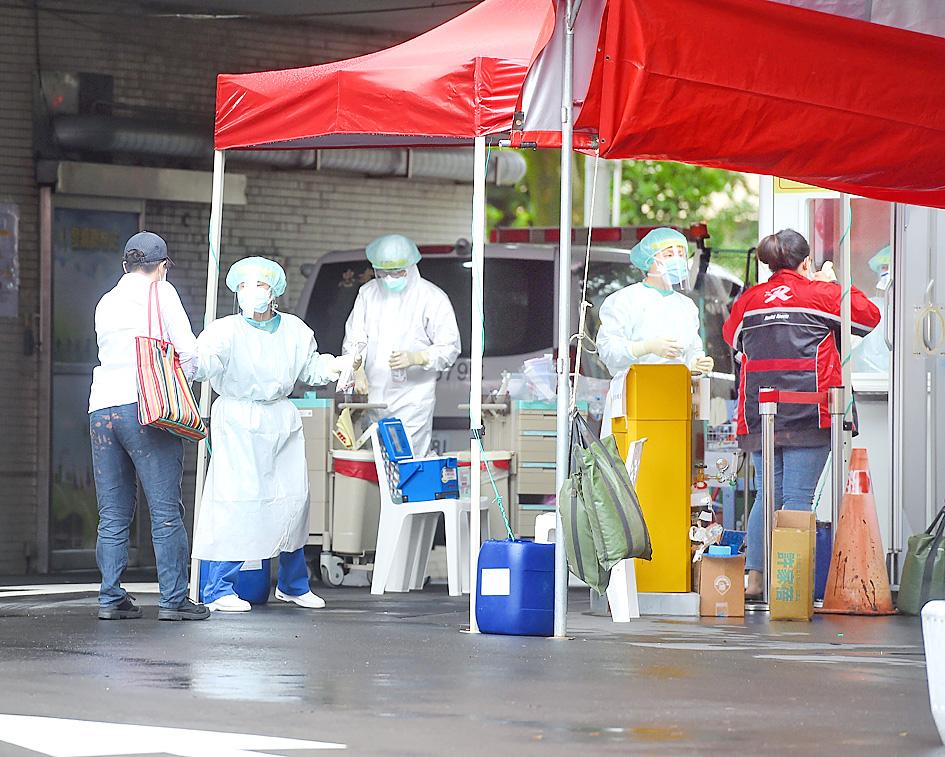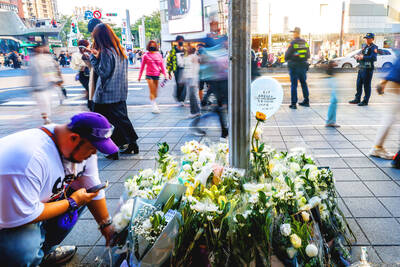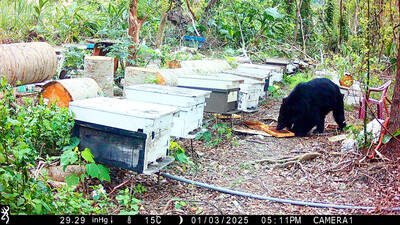Quarantining at home after testing positive for COVID-19 in a rapid screening test would be the “new normal,” Taipei Deputy Mayor Vivian Huang (黃珊珊) said yesterday after the city adjusted its quarantine measures to free up medical facilities for COVID-19 patients with serious symptoms.
The Taipei Department of Health announced a new set of triage procedures for people who have tested positive for COVID-19 at a rapid screening station.
Effective immediately, anyone who is moderately to seriously ill, regardless of age, would be sent to a hospital in an ambulance, the department said.

Photo: Fang Pin-chao, Taipei Times
People with minor symptoms, those who are older than 55, or younger than 55 with chronic diseases or difficulty quarantining at home would be sent to quarantine centers in designated buses or taxis, it said.
Asymptomatic people under 55 would be required to quarantine at home for 17 days and check in daily with their local health center, the department added.
The more than 1,000 people in quarantine hotels would be instructed to return home after 10 days to undergo another seven days of quarantine as long as they are asymptomatic or have not had a fever for more than one day, Huang said.
Quarantine hotels must accept patients with minor symptoms transferred to them by hospitals, as hospitals must focus on treating more serious cases, she added.
Starting yesterday, orders to quarantine at home apply to contacts of confirmed cases, asymptomatic people who have tested positive in a rapid screening and those who are asymptomatic after spending 10 days in a quarantine hotel, Huang said.
“People need to prepare themselves, as living near confirmed cases will be the new normal,” Huang added.
The city must first come to a halt so that sources of infection can be ascertained and chains of infection severed, Huang said.
The cases being announced now were infected more than two weeks ago, she said, adding that further observation is needed over the next two weeks to ascertain whether infections are trending downward.

SHIPS, TRAINS AND AUTOMOBILES: The ministry has announced changes to varied transportation industries taking effect soon, with a number of effects for passengers Beginning next month, the post office is canceling signature upon delivery and written inquiry services for international registered small packets in accordance with the new policy of the Universal Postal Union, the Ministry of Transportation and Communications said yesterday. The new policy does not apply to packets that are to be delivered to China, the ministry said. Senders of international registered small packets would receive a NT$10 rebate on postage if the packets are sent from Jan. 1 to March 31, it added. The ministry said that three other policies are also scheduled to take effect next month. International cruise ship operators

HORROR STORIES: One victim recounted not realizing they had been stabbed and seeing people bleeding, while another recalled breaking down in tears after fleeing A man on Friday died after he tried to fight the knife-wielding suspect who went on a stabbing spree near two of Taipei’s busiest metro stations, Taipei Mayor Chiang Wan-an (蔣萬安) said. The 57-year-old man, identified by his family name, Yu (余), encountered the suspect at Exit M7 of Taipei Main Station and immediately tried to stop him, but was fatally wounded and later died, Chiang said, calling the incident “heartbreaking.” Yu’s family would receive at least NT$5 million (US$158,584) in compensation through the Taipei Rapid Transit Corp’s (TRTC) insurance coverage, he said after convening an emergency security response meeting yesterday morning. National

PLANNED: The suspect visited the crime scene before the killings, seeking information on how to access the roof, and had extensively researched a 2014 stabbing incident The suspect in a stabbing attack that killed three people and injured 11 in Taipei on Friday had planned the assault and set fires at other locations earlier in the day, law enforcement officials said yesterday. National Police Agency (NPA) Director-General Chang Jung-hsin (張榮興) said the suspect, a 27-year-old man named Chang Wen (張文), began the attacks at 3:40pm, first setting off smoke bombs on a road, damaging cars and motorbikes. Earlier, Chang Wen set fire to a rental room where he was staying on Gongyuan Road in Zhongzheng District (中正), Chang Jung-hsin said. The suspect later threw smoke grenades near two exits

The Forestry and Nature Conservation Agency yesterday launched a gift box to market honey “certified by a Formosan black bear” in appreciation of a beekeeper’s amicable interaction with a honey-thieving bear. Beekeeper Chih Ming-chen (池明鎮) in January inspected his bee farm in Hualien County’s Jhuosi Township (卓溪) and found that more than 20 beehives had been destroyed and many hives were eaten, with bear droppings and paw prints near the destroyed hives, the agency said. Chih returned to the farm to move the remaining beehives away that evening when he encountered a Formosan black bear only 20m away, the agency said. The bear